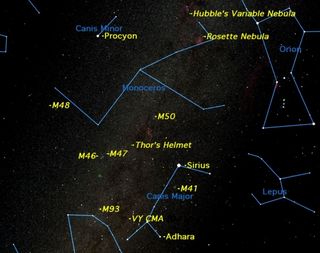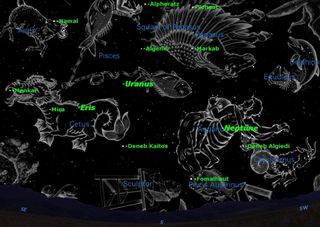
Dog lovers, look up! Skywatchers can now spot four canine constellations prowling the evening sky as darkness falls.
Sirius, the "Dog Star," is the brightest star of the constellation named Canis Major, which means the Greater Dog in Latin. It is also the unquestionable ruler in its own section of the sky, a truly dazzling object. At a distance of 8.7 light-years, Sirius is the fifth nearest star known. Among the naked-eye stars, it is the nearest of all, with the exception of Alpha Centauri. Sirius' color appears a brilliant white tinged with a distinctive bluish hue.
An admirer of Sirius once compared its sparkle to that of a brilliant diamond. Its name appears to derive directly from the Greek word for "sparkling" or "scorching. One can understand how the star received these titles when observing Sirius as it sets, which occurs at about 12:30 a.m. local daylight time. [See amazing night sky photos from skywatchers in March 2014]
When the star is at a low altitude, the thicker layer of air near the horizon causes Sirius' light to scintillate rapidly, making it look as if it's flickering with all the colors of the rainbow. This is when Sirius seems to attract the most attention. People sometimes call their local planetariums inquiring about a "strange and colorful UFO that was dancing above the west-south horizon."

The rest of the stars of Canis Major can somewhat resemble a dog, with a little imagination. In his classic sky guide, "The Stars: A New Way to See Them" (HMH Books for Young Readers, 1976), the late H.A. Rey (1898-1977) used Sirius for a dog tag.
The antithesis of the complex pattern of the Big Dog appears in Canis Minor, the Little Dog. It is composed of just two stars (perhaps instead of the Little Dog, we should call it the "Hot Dog").
The brighter of these two stars is the "Little Dog Star," known as Procyon, the eighth brightest star in the sky. It is a yellow-white star, six times more luminous than the sun.
Get the Space.com Newsletter
Breaking space news, the latest updates on rocket launches, skywatching events and more!
Skywatchers have used the name Procyon since the days of ancient Greece. It is the equivalent of the Latin word "Antecanis" or "Before the Dog," an allusion to the fact that Procyon rises about 20 minutes before Sirius (at mid-northern latitudes), and thus heralds the appearance of the great Dog Star.
High up in the east-northeast sky at around 10 p.m. local daylight time are the Hunting Dogs, known as Canes Venatici. Located about a third of the way from the end of the Big Dipper's handle and below it, these dogs were placed in the sky to assist Boötes, the Bear Driver, in his daily task of pursuing the Big Bear (Ursa Major) around the pole of the heavens.
Like Canis Minor, the Hunting Dogs consist of only two stars, the brightest of which is Cor Caroli, known as "the Heart of Charles."A popular story holds that Edmund Halley gave the star this name in honor of King Charles II of England. This was supposedly done at the suggestion of the court physician Sir Charles Scarborough, who claimed that the star "shone with a special brilliance on the eve of the King's return to London on May 29, 1660." [Best Night Sky Events of April 2014: Stargazing Sky Maps (Gallery)]
However, a deeper dive into this star's history reveals that its original name was "Cor Caroli Regis Martyris" honoring the executed Charles I.
Cor Caroli marks the position of "Chara," one of the two hunting dogs in the mythological outline of the constellation. The other dog is named "Asterion" and is marked by another, fainter star.
This region of the sky also plays host to a few interesting deep-space objects that are worth a look. One of these is Messier 3, a beautiful, bright and condensed globular star cluster. Charles Messier discovered it in 1764, and it can be seen as a hazy, sixth-magnitude "star" in binoculars (sixth magnitude is on the limit of naked-eye visibility).
Three faint galaxies also occupy this region of the sky, located between Canes Venatici and the Big Dipper's handle. Just to the north and forming an isosceles triangle with the dog's two stars is Messier 94, a very compact spiral galaxy. Photographs of M94, which is about 20 million miles (32 million kilometers) from Earth, strongly resemble a hurricane that lacks an eye.
Messier 63, at about 35 million light-years away from Earth, appears nearly twice the size of M94. Photos show a very narrow pattern of spiral arms resembling some vast celestial flower. For this reason, the galaxy has earned the popular name "Sunflower." However, in a modest telescope, it appears only as an oval haze.
Nearby is Messier 51, the famous Whirlpool galaxy, located 35 million light-years away from Earth. In 1845, Messier 51 became the first nebula in which a spiral structure was observed. Lord Rosse saw the shape with his giant, 6-foot (2 meters) reflector at Parsonstown, Ireland. A small telescope shows it as a pair of hazy spots; each one is the center of a galaxy, and these two galaxies are connected.
Editor's note: If you have an amazing skywatching photo you'd like to share for a possible story or image gallery, please contact managing editor Tariq Malik at spacephotos@space.com.
Joe Rao serves as an instructor and guest lecturer at New York's Hayden Planetarium. He writes about astronomy for Natural History magazine, the Farmer's Almanac and other publications, and he is also an on-camera meteorologist for News 12 Westchester, N.Y. Follow us @Spacedotcom, Facebookand Google+. Original article on Space.com.
Join our Space Forums to keep talking space on the latest missions, night sky and more! And if you have a news tip, correction or comment, let us know at: community@space.com.

Joe Rao is Space.com's skywatching columnist, as well as a veteran meteorologist and eclipse chaser who also serves as an instructor and guest lecturer at New York's Hayden Planetarium. He writes about astronomy for Natural History magazine, the Farmers' Almanac and other publications. Joe is an 8-time Emmy-nominated meteorologist who served the Putnam Valley region of New York for over 21 years. You can find him on Twitter and YouTube tracking lunar and solar eclipses, meteor showers and more. To find out Joe's latest project, visit him on Twitter.
Most Popular


